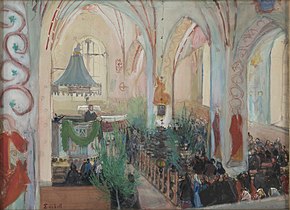Church of St. Lawrence, Lohja
- Machine translation, like DeepL or Google Translate, is a useful starting point for translations, but translators must revise errors as necessary and confirm that the translation is accurate, rather than simply copy-pasting machine-translated text into the English Wikipedia.
- Do not translate text that appears unreliable or low-quality. If possible, verify the text with references provided in the foreign-language article.
- You must provide copyright attribution in the edit summary accompanying your translation by providing an interlanguage link to the source of your translation. A model attribution edit summary is
Content in this edit is translated from the existing Finnish Wikipedia article at [[:fi:Lohjan Pyhän Laurin kirkko]]; see its history for attribution. - You may also add the template
{{Translated|fi|Lohjan Pyhän Laurin kirkko}}to the talk page. - For more guidance, see Wikipedia:Translation.

The Church of St. Lawrence (Finnish: Lohjan Pyhän Laurin kirkko, Swedish: Sankt Lars kyrka) is a church in Lohja, Finland. It is the third largest medieval parish church in Finland. The murals from early 16th century make it one of the most valuable medieval buildings in Finland.[1] The rustic and naive murals depicted biblical stories for the illiterate population.[2]
Description
Prior to the Protestant Reformation and the introduction of Lutheranism into Finland, the church served the Roman Catholic Church. The church is dedicated to Lawrence of Rome.[3]
On the southeast corner of the church is a bell tower. Its grey stone foot is probably from the Middle Ages. The wooden parts of the bell tower were given their present form during the vast reparations after the Great Northern War.[4] The construction of the upper part was overseen by German master builder Johann Friedrich Schultz around year 1740. The tower houses three bells, the oldest of which was cast in Tallinn in 1594. The largest of the bells was cast in Lohja in 1624 and the smallest was cast in Stockholm in 1740.[5]
In early 19th century the church windows were made larger and the paintings were covered with white chalk colour. In 1880s the white paint was removed and colourful figures were repaired.[6]
Gallery
-
 Interior view of Lohja Church showing the vivid medieval paintings executed in 1510s.
Interior view of Lohja Church showing the vivid medieval paintings executed in 1510s. -
 Bell tower. The masonry part dates probably to the Middle Ages and the wooden part was constructed around year 1740.
Bell tower. The masonry part dates probably to the Middle Ages and the wooden part was constructed around year 1740. -
 Midsummer Day Service in Lohja Church by Magnus Enckell in 1899
Midsummer Day Service in Lohja Church by Magnus Enckell in 1899
See also
References

- ^ "Lohjan kirkko ympäristöineen" (in Finnish). National Board of Antiquities. 2009. Retrieved 26 December 2016.
- ^ "Pyhän Laurin Kirkko". Lonely Planet. Retrieved 26 December 2016.
- ^ "Pyhä Laurentius" (in Finnish). Lohja Parish. Archived from the original on 26 December 2016. Retrieved 26 December 2016.
- ^ "Churches". Visit Lohja. Retrieved 26 December 2016.
- ^ "Kirkkorakennus ja kellotapuli" Archived 2017-02-25 at the Wayback Machine (in Finnish). Lohja Parish. Retrieved 24 November 2017.
- ^ "Keskiaikainen Lohjan harmaakivikirkko" (in Finnish). Lohja Parish. Archived from the original on 26 December 2016. Retrieved 26 December 2016.
60°15′11″N 24°04′04″E / 60.2531°N 24.0678°E / 60.2531; 24.0678












